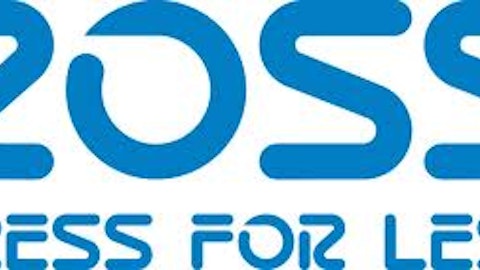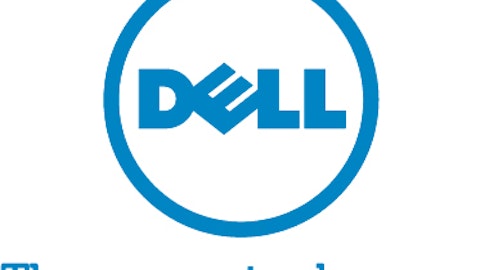There has never been a technology that took over our lives like smartphones. After International Business Machines Corp. (NYSE:IBM) released its first PC in 1981, it took nearly 20 years before 100 million PCs were sold a year. We’re now closing in on six years since the first iPhone’s launch, and more than 200 million smartphones were shipped last quarter alone. Hot on the heels behind smartphones are tablets, which look poised to overtake PC sales themselves within the next three years.

If the PC was like vines slowly overgrowing the technology space, then the smartphone and tablet have been wildfire, moving fast and destroying everything in their path.
While the media has focused on how mobile products — both smartphones and tablets — threaten PC-dependent companies such as Microsoft Corporation (NASDAQ:MSFT) and Dell Inc. (NASDAQ:DELL), those companies are just a small part of a storyline in which all consumer electronics-spending is being shaken up. The truth is, the damage mobile spending is doing to Microsoft is nothing compared with how the trend is ravaging Sony Corporation (ADR) (NYSE:SNE) .
Even worse, the reality is that we’re now ending a first phase of the mobile transition, and the next phase could be even more damaging to the company and its peers.
Let’s take a look at Sony Corporation (ADR) (NYSE:SNE), and why the future is about to get a lot more dangerous.

It’s nearly impossible to avoid Sony Corporation (ADR) (NYSE:SNE). With its TVs, video-game systems, movie studio, and record label, the company is a dominant media force. Yet if you think Sony is primarily a consumer electronics and media company, you’re wrong.
Shockingly, almost all of Sony Corporation (ADR) (NYSE:SNE)’s profits come not from home electronics, but instead from its financial services segment. Yes, Sony Corporation (ADR) (NYSE:SNE) has become really just a life insurance company. Just look at how things shake out at the company.
| Segment | Operating Profit (Millions of U.S. Dollars) | Sales (Millions of U.S. Dollars) |
|---|---|---|
| Financial Services (Life Insurance, Banking) | $1,595 | $10,590 |
| Music (Sony Music) | $448 | $5,373 |
| Movie (Sony/Columbia Pictures) | $414 | $7,981 |
| Game (PlayStation) | $356 | $9,768 |
| Imaging (Cameras) | $226 | $9,238 |
| Mobile Products (Cell Phones) | $88 | $7,556 |
| Devices (Components and Chemicals) | ($269) | $12,456 |
| Home Entertainment and Sound (TVs, AV Equipment) | ($2,466) | $15,570 |
Source: S&P Capital IQ. Figures are from the trailing 12 months of operations.
Sony Corporation (ADR) (NYSE:SNE) is an absolute force in most these segments. In music, it’s the second largest record label, while its movie studio’s films raked in $1.8 billion in the U.S. last year, enough to beat Time Warner Inc (NYSE:TWX) and The Walt Disney Company (NYSE:DIS) to make Sony the highest-grossing studio. Finally, its PlayStation line-up sold more than six times the next closest video game console early last decade during the reign of the PlayStation 2. While Sony has seen less success with the PlayStation 3, it’s still a dominant player in video games.
Yet the one thing most consumers had no idea Sony was involved in — life insurance and banking — is literally more profitable than its video games, cameras, music label, and movie studio, combined.
Apple Inc. (NASDAQ:AAPL): 628 times more mobile profits than Sony
While Sony’s banking arm churns out most of the company’s profits, most of its sales and infrastructure lay in other units. Two of the most deeply ailing are its mobile-products and home-entertainment division.
Mobile products is slightly profitable before taxes. However, its $88 million in pre-tax operating profit is laughable when stacked up to Apple Inc. (NASDAQ:AAPL)’s $55.2 billion in profit during the same period that’s driven largely from the iPhone. For those of you who like really big numbers, Apple Inc. (NASDAQ:AAPL)’s operating profit is 628 times larger than Sony’s mobile profit.
The irrelevance of Sony’s mobile division extends beyond the results of that segment itself. iPads sell for a higher cost than many large televisions. Sony’s digital camera sales are off as smartphones increasingly become the point-and-click camera of choice. Blu-ray has never taken off the way DVD sales did last decade as consumers use tablets to buy digital media, or increasingly stream it from services like Netflix, Inc. (NASDAQ:NFLX).
Sony Corporation (ADR) (NYSE:SNE) is at the mercy of all these changes, and its mobile unit isn’t relevant enough to offset its losses elsewhere.
Buy a smartphone, not a camera. A tablet, not a TV.
The problem is that while consumer spending isn’t a zero-sum game, it’s close. In 2012, the industry was worse than a zero-sum game, with total spending falling. In 2013, consumer technology spending is supposed to bounce back. However, even optimistic projections expect growth to be in the low single digits this year.
If consumers spend their money on a tablet, that doesn’t mean they’re expanding their electronics spending. It means they’re forgoing another purchase like a new TV.
The trend is most starkly evidenced by data from market researcher NPD. Out of the five largest spending categories on consumer electronics, everything is shrinking except smartphones and tablets.
| Category | 2011 Sales Growth | 2012 Sales Growth |
|---|---|---|
| Tablets | 135% | 42% |
| Smartphones | 28% | 25% |
| Flat-Panel TVs | (5%) | (7%) |
| Notebook Computers | (2%) | (9%) |
| Desktop Computers | 9% | (11%) |
Source: NPD Research. Results are for U.S. spending.
Beyond these main categories, the pain extends to other areas of spending where Sony has a big presence. Video-game sales decreased 9% to $14.8 billion. Sony’s camera sales are off 17% in the past 12 months.
The Swiss Army knife of technology
One of the great disruption points of smartphones and tablets is what Swiss Army knives they are. Take for example, calculators. With smartphones coming with built-in calculators and advanced ones available for download from Apps stores for low-fees, the market for standalone calculators still exists, but it’s been thinned down to students and more demanding professionals.
That situation is not too dissimilar from cameras, video games, or physical media. It’s not that if you go to Best Buy Co., Inc. (NYSE:BBY) that you won’t still see Sony Blu-ray players, cameras, and PlayStations moving off the shelves. Instead, it’s that a reasonable percentage of consumers are using mobile devices like smartphones and tablets instead of dedicated separate consumer electronics.
Previously, if you wanted a video camera, your only option was paying a few hundred dollars for a standalone unit. Perhaps 75% of consumers were happy happy enough to do so. However, if 25% find a smartphone’s built-in video camera capable enough to forgo a purchase of a standalone camera, that devastates the industry.
Go back and look at Sony Corporation (ADR) (NYSE:SNE)’s camera division, and you’ll find operating margins of an anemic 2.5%. For comparison, Wal-Mart Stores, Inc. (NYSE:WMT), a company synonymous with taking every measure to sell items cheaply and undercut competitors, has operating margins of 5.9%, a level double Sony’s camera division. Even its vaunted video-game division had operating margins of 3.6% last quarter, below Wal-Mart. Its sales were off 6% from last year, and research shows the U.S. gaming population dropped 5% last year. Video games aren’t dying; the economics are just being chipped away, with the minority of gamers who are content with games on their phone shifting away from console games.
The point here is that Sony Corporation (ADR) (NYSE:SNE) specializes in hardware to meet many different markets. Yet increasingly, a percentage of users is shifting from specialized hardware to handle functions like taking pictures to letting an all-in-one device like iPhones with specialized software handle their electronics needs.
Borders didn’t die because everyone stopped buying books. It died because one year 11% fewer people bought books. Then the next year 14% fewer people bought books. Then finally in its last year, 16% fewer people bought books, and it couldn’t adjust its cost structure fast enough to handle the changes.
Sony cut 10,000 jobs last year to address the changing state of consumer-electronics spending. Yet even that massive lay-off number was just 6% of its workforce.
It gets worse
The problem for Sony Corporation (ADR) (NYSE:SNE) is that so far, smartphones and tablets have merely shifted consumer spending. In the next phase, they could define it.
Take, for example, Sonos, a wireless system. It’s proved to be an extremely popular product, as different music can be streamed wirelessly and controlled to each room in the house.
Yet the beauty of Sonos is in its simplicity and software. There’s no litany of audio jacks on the back since music is streamed wirelessly. Well-developed software controls the music’s flow through the house. Finally, the software runs on either Apple Inc. (NASDAQ:AAPL)’s iOS platform or Google Inc (NASDAQ:GOOG)‘s Android.
Sonos not only kills the kind of home-theater experience that Sony is used to, but it also entrenches home electronics as vassals to platforms like Android and iOS.
Therein lies the problem for Sony. The next generation of electronics is increasingly defined by its ability to tie into a platform. Sony uses Android, but it owns no dominant platforms of its own. If next-generation home-theater systems focus on simplicity and tie-ins to great software, where does that leave Sony? In the past, the company has been crippled in the software arena. It tried to make competitive software offerings, but it has all too often been crippled by making concessions to its media divisions. Later, true disruptors like iTunes arrived.
A battle it can’t win
Sony’s other segments, like movies and music and, well, life insurance, are doing well. They’re just not doing well enough to make up for how terribly its home-electronics and other businesses are doing.
There will always be a market for high-quality video games. There will always be a market for high-end SLRs that professionals rely on. Televisions will need speakers. There will be companies that survive these shifts and manage to thrive in a smaller, more niche market of tomorrow.
Yet there may not be a need for a huge sprawling corporation like Sony, with its lack of focus on any one niche area and huge corporate expense structure to control them.
Five years ago, Sony Corporation (ADR) (NYSE:SNE) was one of the most impressive technology companies on Earth. Today, it’s a life insurance company. In five years, it could be gone.
Major technology shifts occur rapidly, and as we’ve seen in past ones, even some of the world’s largest companies on the wrong side can falter. Technology moves fast. Giant, sprawling businesses, all too often, don’t.
The article How Apple, Smartphones, and Tablets Are Killing Sony originally appeared on Fool.com and is written by Eric Bleeker, CFA.
Eric Bleeker, CFA, has no position in any stocks mentioned. The Motley Fool recommends Apple, Netflix, and Walt Disney (NYSE:DIS) and owns shares of Apple, Microsoft, Netflix, and Walt Disney.
Copyright © 1995 – 2013 The Motley Fool, LLC. All rights reserved. The Motley Fool has a disclosure policy.




